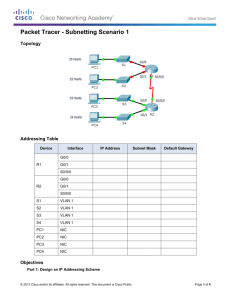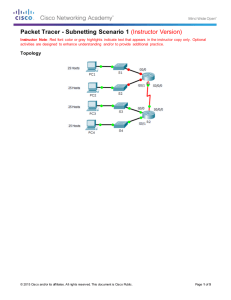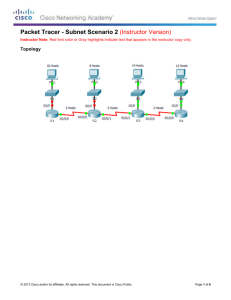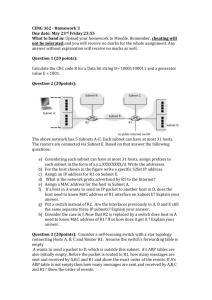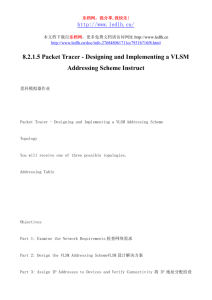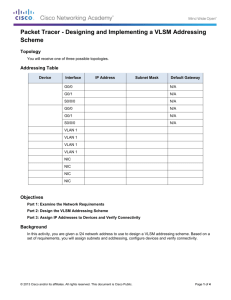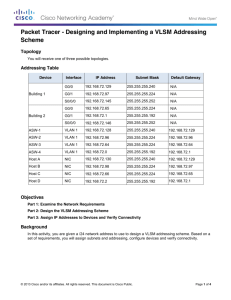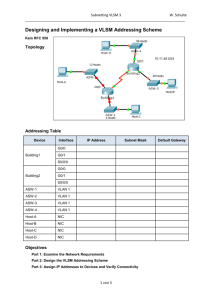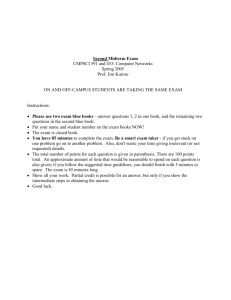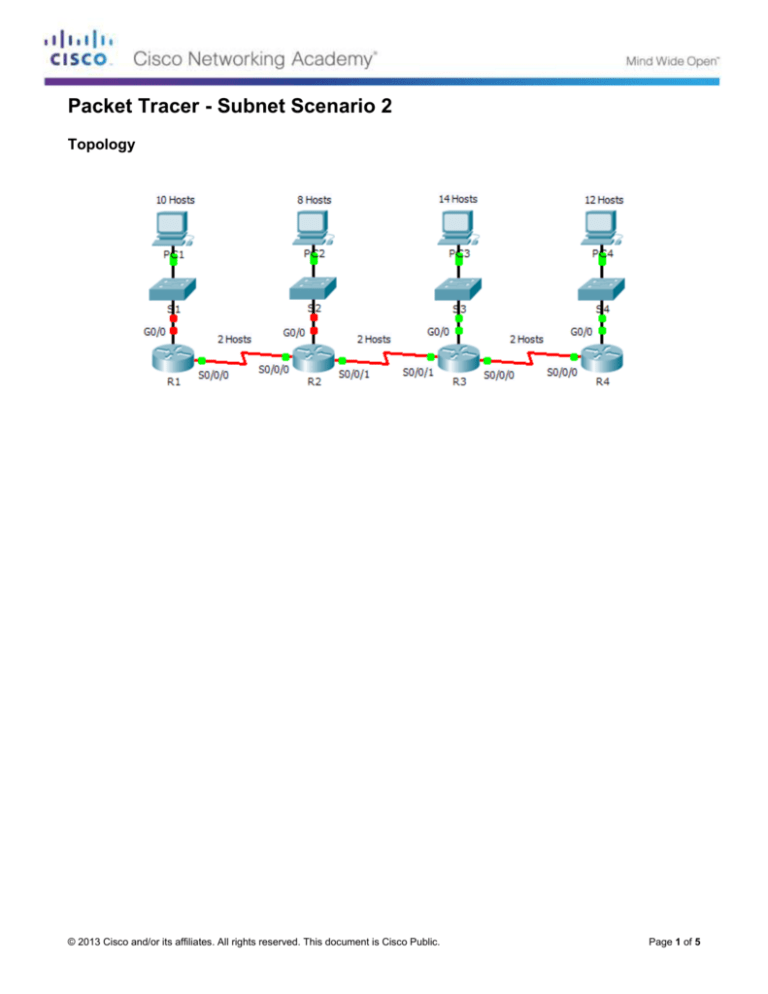
Packet Tracer - Subnet Scenario 2
Topology
© 2013 Cisco and/or its affiliates. All rights reserved. This document is Cisco Public.
Page 1 of 5
Packet Tracer - Subnet Scenario 2
Addressing Table
Device
Interface
IP Address
Subnet Mask
Default Gateway
G0/0
N/A
S0/0/0
N/A
G0/0
N/A
S0/0/0
N/A
S0/0/1
N/A
G0/0
N/A
S0/0/0
N/A
S0/0/1
N/A
G0/0
N/A
R4
S0/0/0
N/A
S1
VLAN 1
S2
VLAN 1
S3
VLAN 1
S4
VLAN 1
PC1
NIC
PC2
NIC
PC3
NIC
PC4
NIC
R1
R2
R3
Objectives
Part 1: Design an IP Addressing Scheme
Part 2: Assign IP Addresses to Network Devices and Verify Connectivity
Scenario
In this activity, you are given the network address of 172.31.1.0 /24 to subnet and provide the IP addressing for
the network shown in the Topology. The required host addresses for each WAN and LAN link are labeled in the
topology.
Part 1: Design an IP Addressing Scheme
Step 1: Subnet the 172.31.1.0/24 network based on the maximum number of hosts required by
the largest subnet.
a. Based on the topology, how many subnets are needed?
b. How many bits must be borrowed to support the number of subnets in the topology table?
© 2013 Cisco and/or its affiliates. All rights reserved. This document is Cisco Public.
Page 2 of 5
Packet Tracer - Subnet Scenario 2
c.
How many subnets does this create?
d. How many usable host addresses does this create per subnet?
Note: If your answer is less than the 14 maximum hosts required for the R3 LAN, then you borrowed too
many bits.
e. Calculate the binary value for the first five subnets. Subnet zero is already shown.
Net 0: 172 . 31 . 1 .
0
0
0
0
0
0
0
0
Net 1: 172 . 31 . 1 . ___ ___ ___ ___ ___ ___ ___ ___
Net 2: 172 . 31 . 1 . ___ ___ ___ ___ ___ ___ ___ ___
Net 3: 172 . 31 . 1 . ___ ___ ___ ___ ___ ___ ___ ___
Net 4: 172 . 31 . 1 . ___ ___ ___ ___ ___ ___ ___ ___
f.
Calculate the binary and decimal value of the new subnet mask.
11111111.11111111.11111111. ___ ___ ___ ___ ___ ___ ___ ___
255
.
255
.
255
. ______
g. Complete the Subnet Table, listing all available subnets, the first and last usable host address, and the
broadcast address. The first subnet is done for you. Repeat until all addresses are listed.
Note: You may not need to use all rows.
© 2013 Cisco and/or its affiliates. All rights reserved. This document is Cisco Public.
Page 3 of 5
Packet Tracer - Subnet Scenario 2
Subnet Table
Subnet
Number
0
Subnet IP
172.31.1.0
First Usable
Host IP
172.31.1.1
Last Usable
Host IP
172.31.1.14
Broadcast
Address
172.31.1.15
1
2
3
4
5
6
7
8
9
10
11
12
13
14
15
Step 2: Assign the subnets to the network shown in the topology.
When assigning the subnets, keep in mind that routing is necessary to allow information to be sent throughout
the network.
a. Assign Subnet 0 to the R1 LAN:
b. Assign Subnet 1 to the R2 LAN:
c.
Assign Subnet 2 to the R3 LAN:
d. Assign Subnet 3 to the R4 LAN:
e. Assign Subnet 4 to the link between
f.
Assign Subnet 5 to the link between
g. Assign Subnet 6 to the link between
Step 3: Document the addressing scheme.
Complete the Addressing Table using the following guidelines:
a. Assign the first usable IP addresses to routers for each of the LAN links.
b. Use the following method to assign WAN link IP addresses:
© 2013 Cisco and/or its affiliates. All rights reserved. This document is Cisco Public.
Page 4 of 5
Packet Tracer - Subnet Scenario 2
c.
For the WAN link between R1 and R2, assign the first usable IP address to R1 and last usable IP
address R2.
For the WAN link between R2 and R3, assign the first usable IP address to R2 and last usable IP
address R3.
For the WAN link between R3 and R4, assign the first usable IP address to R3 and last usable IP
address R4.
Assign the second usable IP addresses to the switches.
d. Assign the last usable IP addresses to the hosts.
Part 2: Assign IP Addresses to Network Devices and Verify Connectivity
Most of the IP addressing is already configured on this network. Implement the following steps to complete
the addressing configuration.
Step 1: Configure IP addressing on R1 and R2 LAN interfaces.
Step 2: Configure IP addressing on S3, including the default gateway.
Step 3: Configure IP addressing on PC4, including the default gateway.
Step 4: Verify connectivity.
You can only verify connectivity from R1, R2, S3, and PC4. However, you should be able to ping every IP
address listed in the Addressing Table.
Suggested Scoring Rubric
Question
Location
Possible
Points
Step 1a
1
Step 1b
1
Step 1c
1
Step 1d
1
Step 1e
4
Step 1f
2
Complete Subnet Table
Step 1g
10
Assign Subnets
Step 2
10
Document Addressing
Step 3
40
Activity Section
Part 1: Design an IP
Addressing Scheme
Part 1 Total
70
Packet Tracer Score
30
Total Score
100
© 2013 Cisco and/or its affiliates. All rights reserved. This document is Cisco Public.
Earned
Points
Page 5 of 5

